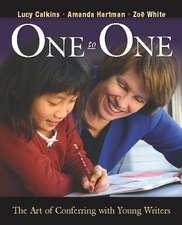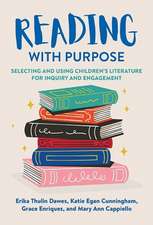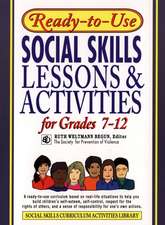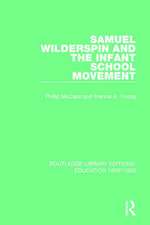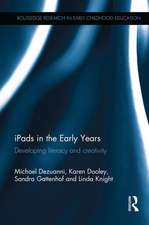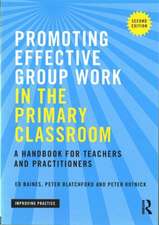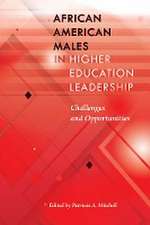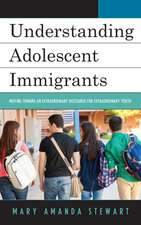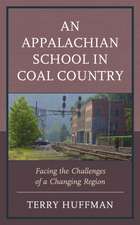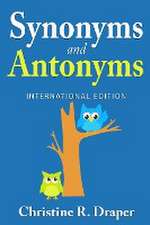Story: Still the Heart of Literacy Learning
Autor Katie Cunninghamen Limba Engleză Paperback – 26 oct 2015
- How to build a diverse, multicultural classroom library that reflects all voices through rich, purposeful, and varied texts
- Numerous examples of multi-genre and multi-modal stories from children's and young adult literature
- A practical toolkit at the end of each chapter to demonstrate how to make stories come alive in any classroom
Preț: 160.11 lei
Preț vechi: 192.90 lei
-17% Nou
Puncte Express: 240
Preț estimativ în valută:
30.64€ • 31.99$ • 25.30£
30.64€ • 31.99$ • 25.30£
Carte tipărită la comandă
Livrare economică 15-29 aprilie
Preluare comenzi: 021 569.72.76
Specificații
ISBN-13: 9781625310248
ISBN-10: 1625310242
Pagini: 208
Dimensiuni: 187 x 235 x 13 mm
Greutate: 0.43 kg
Ediția:1
Editura: Taylor & Francis
Colecția Routledge
Locul publicării:Oxford, United Kingdom
ISBN-10: 1625310242
Pagini: 208
Dimensiuni: 187 x 235 x 13 mm
Greutate: 0.43 kg
Ediția:1
Editura: Taylor & Francis
Colecția Routledge
Locul publicării:Oxford, United Kingdom
Public țintă
Professional Practice & DevelopmentRecenzii
Katie Cunningham’s Story: Still the Heart of Literacy Learning reminds us that stories found in literature, poetry, music, art and illustration, multimedia, and throughout all aspects of our lives serve to move us, inform us, and call us to action. What’s more, these narratives provide an invaluable teaching resource to attract young readers and writers and, subsequently, to deepen their understanding of the world. Cunningham offers intriguing and effective steps to help our students strengthen their literacy skills through the reading and writing of story, and it is my hope that this book will encourage teachers to restore the study of story to its rightful place in the curriculum. — Kelly Gallagher, author of In the Best Interest of Students (Stenhouse, 2015)This book about teaching story is written in such a passionate tone that it reads like a story itself! Throughout her book, Cunningham uses anecdotes from her own work teaching children and conducting professional development to both clarify and breathe life into her arguments. In Chapter l, she puts forward the idea that story is the primary vehicle through which people learn about them selves and the world. She advocates sharing personal stories in the classroom as they pull students in and create community. As the students get to know the teacher and each other through their stories, they become more comfortable with risk-taking and the vulnerability that comes from revealing that which affects them deeply. As teachers get to know their students, they can provide better teaching. Cunningham calls for teachers to closely read students for their stories the way we ask students to closely read text.
By providing students with stories about people like them, students learn their own stories are important. In the second chapter, Cunningham urges teachers to provide materials for students from diverse backgrounds, not only from traditional print stories but from art, music, video, photography, podcasts, and poetry as well. When teachers provide a rich variety of sources, students delve into the complexities of topics and view them from multiple perspectives. This chapter includes a table organized by themes, such as courage, well ness, and freedom, with guiding questions for 5th through 8th grades, and texts of many types for students to explore. lt also identifies blogs and websites that help teachers find texts.
Chapter 3 is about where stories "live"; it expands on Chapter l, elaborating on the ways in which stories enrich and even change our lives in ways nothing else can.
Cunningham encourages us to seek out stories with characters that come to life for readers, themes that go beyond the story, and events that make us want to keep reading. She identifies mentor texts for each of these qualities at every grade level. She explains how students can also find stories in poetry and music, visual arts, and multi media, all of which have a unique potential to help students both interpret and create stories. My personal favorite is the mashup. Mash-ups take an existing work and use it to create new stories. Any medium or combination of media can be used, and the pre-existing work can serve as a mentor text that both invites critical comprehension and scaffolds story creation.
The Common Core is never far from any teacher's thoughts these days, and in the fourth chapter, Cunningham explores the many different ways in which teachers can employ close reading to bring stories to life. Close examination is actually a more appropriate term as Cunningham once again advocates the use of multiple media to employ the technique. A chart summarizes ways to have students examine songs, poems, and visual art closely, developing skills and strategies they can apply to print text. As Cunningham points out, many students have more of an affinity for music and visual art than they do for print text, so starting with these media both meets the students where they are and helps build a bridge to print interpretation and analysis. In this chapter, she encourages teachers to use deeply engaging stories as often as possible, even when conducting guided reading with emergent readers. Wordless picture books, for example, allow the youngest readers to zoom in on illustrations the way they zoom in on images that surround them in their daily lives. Cunningham suggests several wordless picture book rides for older as well as younger children, explaining the potential of each one. The chapter concludes with a sample lesson.
In her chapter on writing stories, Cunningham fully embraces the reading writing connection, arguing that the best way to elicit story ideas from students and teach them to use appropriate words and sentence structure is to call their attention to all of those elements in the stories they love. Included in this chapter are two sample lessons that draw on children's literature to help students identify expert use of language choice and sentence structure, and practice using chose writing traits them selves. Also included are ideas for teaching story structure with digital stories, a type of creative expression in which many students can excel.
In expressing her final thoughts, Cunningham acknowledges the courage it cakes to let defenses down and teach in the manner she describes. She also ardently encourages teachers to try it and to experience its rewards.
- Summer 2016 edition of the Illinois Reading Council Journal
By providing students with stories about people like them, students learn their own stories are important. In the second chapter, Cunningham urges teachers to provide materials for students from diverse backgrounds, not only from traditional print stories but from art, music, video, photography, podcasts, and poetry as well. When teachers provide a rich variety of sources, students delve into the complexities of topics and view them from multiple perspectives. This chapter includes a table organized by themes, such as courage, well ness, and freedom, with guiding questions for 5th through 8th grades, and texts of many types for students to explore. lt also identifies blogs and websites that help teachers find texts.
Chapter 3 is about where stories "live"; it expands on Chapter l, elaborating on the ways in which stories enrich and even change our lives in ways nothing else can.
Cunningham encourages us to seek out stories with characters that come to life for readers, themes that go beyond the story, and events that make us want to keep reading. She identifies mentor texts for each of these qualities at every grade level. She explains how students can also find stories in poetry and music, visual arts, and multi media, all of which have a unique potential to help students both interpret and create stories. My personal favorite is the mashup. Mash-ups take an existing work and use it to create new stories. Any medium or combination of media can be used, and the pre-existing work can serve as a mentor text that both invites critical comprehension and scaffolds story creation.
The Common Core is never far from any teacher's thoughts these days, and in the fourth chapter, Cunningham explores the many different ways in which teachers can employ close reading to bring stories to life. Close examination is actually a more appropriate term as Cunningham once again advocates the use of multiple media to employ the technique. A chart summarizes ways to have students examine songs, poems, and visual art closely, developing skills and strategies they can apply to print text. As Cunningham points out, many students have more of an affinity for music and visual art than they do for print text, so starting with these media both meets the students where they are and helps build a bridge to print interpretation and analysis. In this chapter, she encourages teachers to use deeply engaging stories as often as possible, even when conducting guided reading with emergent readers. Wordless picture books, for example, allow the youngest readers to zoom in on illustrations the way they zoom in on images that surround them in their daily lives. Cunningham suggests several wordless picture book rides for older as well as younger children, explaining the potential of each one. The chapter concludes with a sample lesson.
In her chapter on writing stories, Cunningham fully embraces the reading writing connection, arguing that the best way to elicit story ideas from students and teach them to use appropriate words and sentence structure is to call their attention to all of those elements in the stories they love. Included in this chapter are two sample lessons that draw on children's literature to help students identify expert use of language choice and sentence structure, and practice using chose writing traits them selves. Also included are ideas for teaching story structure with digital stories, a type of creative expression in which many students can excel.
In expressing her final thoughts, Cunningham acknowledges the courage it cakes to let defenses down and teach in the manner she describes. She also ardently encourages teachers to try it and to experience its rewards.
- Summer 2016 edition of the Illinois Reading Council Journal
Cuprins
Introduction; Chapter 1: Why Stories Matter; Chapter 2: Whose Stories Count?; Chapter 3: Where Do Stories Live?; Chapter 4: How Can Stories Come to Life?; Chapter 5: How Do We Build Stories?; Chapter 6: How Do We Talk About Stories?; Chapter 7: Why This Work Takes Courage
Notă biografică
Katie Egan Cunningham is a veteran classroom teacher, a literacy consultant, and an assistant professor at Manhattanville College. She is the coauthor of the popular blog The Classroom Bookshelf as well as the coauthor of Literacy Leadership in Changing Schools (Teachers College Press, 2015). She lives with her husband and two sons where hilarious, heartfelt stories happen each day.
Descriere
Stories are all around us. From our digital newsfeeds, interactions with one another, to watching a movie or listening to a curated playlist, we see and hear different tales told to us in various ways.

